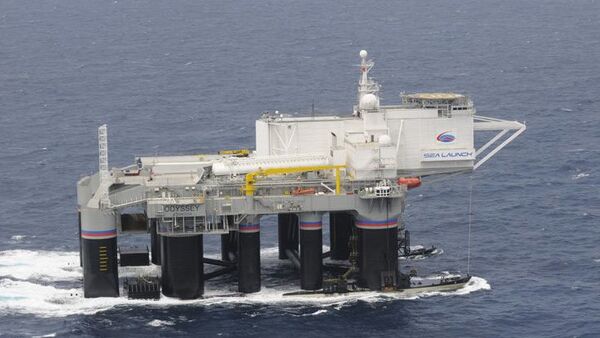MOSCOW, March 18 (RIA Novosti) - Sea Launch AG plans to launch a satellite for US satellite services provider Echostar Corp. from its Pacific Ocean-based Odyssey platform in 2015, the companies said Monday.
Sea Launch and Echostar said in a joint statement that the satellite would be launched using a Zenit-3SL vehicle.
This marks the first launch announcement by Sea Launch since one of its Zenit vehicles carrying an Intelsat-27 telecommunications satellite crashed shortly after lift-off on February 1.
Russian officials blamed the incident on Ukrainian-made components and insisted no defects were found in Russian equipment.
Zenit-3SL “is ideally suited for launching heavyweight-class spacecraft, with multiple restart capability and heavy-lift performance,” Sea Launch and Echostar said in their joint statement.
EchoStar Satellite Services president Anders Johnson said the preliminary agreement with Sea Launch would give his company flexibility to accommodate its launch requirements as it expands its North American fleet.
"We have been pleased with Sea Launch's performance on past missions and look forward to continued success," Johnson said.
EchoStar Satellite Services is a wholly owned subsidiary of EchoStar Corp.
The Zenit-3SL integrated launch vehicle is a liquid-propellant rocket consisting of three stages and a payload unit.
The first stage is powered by the RD-171M engine designed by Russia’s NPO Energomash rocket engine design bureau. The RD-171M is one of the most powerful rocket engines in the world, producing 740,000 kilograms of thrust at liftoff.
Sea Launch was formed in 1995 as a consortium of four companies from Norway, Russia, Ukraine and the United States, and was managed by US aerospace giant Boeing. The project aimed to use a floating launch site to place rockets on the equator - the best possible location for launch _ which gives the rocket additional speed on lift-off thanks to centripetal force caused by Earth's rotation.
Sea Launch resumed operations in 2011 after a 30-month hiatus that saw passage through US Chapter 11 bankruptcy, a change in ownership from Boeing to Russia’s Energia, and a move of the company headquarters from California to Switzerland.
Energia now holds a 95 percent stake in Sea Launch.
Of the 34 previous Sea Launch rocket launches since 1999, three have failed, with a fourth placing its payload into an incorrect but recoverable orbit.
The first failure occurred on March 12, 2000, when a software error resulted in premature cut-off of the second stage, leaving its ICO F-1 satellite unable to reach orbit.
On June 29, 2004, during the launch of an Apstar 5 satellite, the upper stage shut down 54 seconds early due to a wiring fault, leaving the satellite in a lower than planned orbit.
A Zenit-3SL exploded on the launch pad on January 30, 2007, after an engine failure caused by debris in the turbo pump. The payload on that flight was an NSS-8 communications satellite for SES New Skies.
On February 1, the Zenit-3SL carrying an Intelsat-27 satellite crashed into the Pacific Ocean shortly after launch, following an emergency shutdown of its first-stage engine.
A report presented by Deputy Prime Minister Dmitry Rogozin to Prime Minister Dmitry Medvedev concluded that “the accident was caused by defective blocks manufactured in Ukraine,” and that “there was nothing wrong with the Russian-made equipment.”

